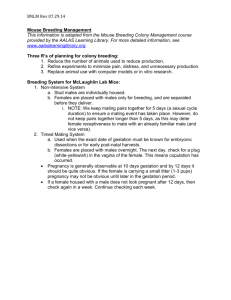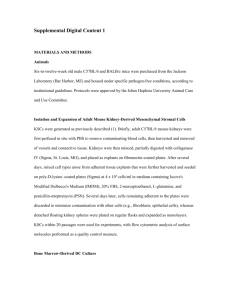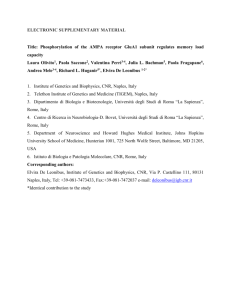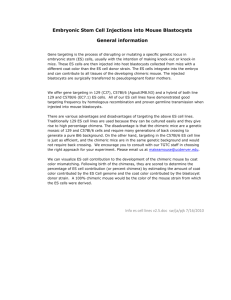Early maternal cannibalism in laboratory mice: strain but not parity
advertisement
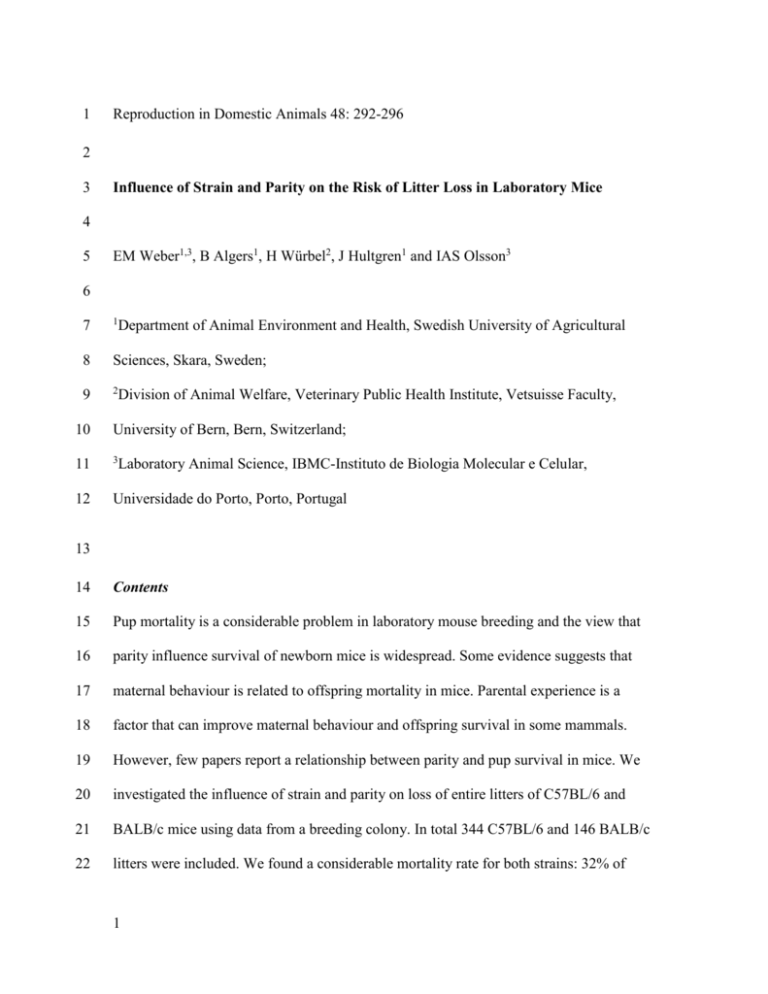
1 Reproduction in Domestic Animals 48: 292-296 2 3 Influence of Strain and Parity on the Risk of Litter Loss in Laboratory Mice 4 5 EM Weber1,3, B Algers1, H Würbel2, J Hultgren1 and IAS Olsson3 6 7 1 8 Sciences, Skara, Sweden; 9 2 Department of Animal Environment and Health, Swedish University of Agricultural Division of Animal Welfare, Veterinary Public Health Institute, Vetsuisse Faculty, 10 University of Bern, Bern, Switzerland; 11 3 12 Universidade do Porto, Porto, Portugal Laboratory Animal Science, IBMC-Instituto de Biologia Molecular e Celular, 13 14 Contents 15 Pup mortality is a considerable problem in laboratory mouse breeding and the view that 16 parity influence survival of newborn mice is widespread. Some evidence suggests that 17 maternal behaviour is related to offspring mortality in mice. Parental experience is a 18 factor that can improve maternal behaviour and offspring survival in some mammals. 19 However, few papers report a relationship between parity and pup survival in mice. We 20 investigated the influence of strain and parity on loss of entire litters of C57BL/6 and 21 BALB/c mice using data from a breeding colony. In total 344 C57BL/6 and 146 BALB/c 22 litters were included. We found a considerable mortality rate for both strains: 32% of 1 23 C57BL/6 litters and 20% for BALB/c litters were lost. There was a significant difference 24 in survival of first litter between strains, with 3.6 times higher odds of mortality in 25 C57BL/6 mice (P=0.0028). Parity or previous parental experience of litter loss did, 26 however, not affect litter loss. 27 The scientific literature does not provide a clear picture of perinatal mortality in 28 laboratory mice. Very few studies report perinatal mortality and only a handful of papers 29 exist where mortality was systematically studied; this area is thus poorly understood. If 30 perinatal mortality in mice is not recognized and investigated, but instead considered 31 normal when breeding mice, a serious welfare problem might be overlooked. 32 33 Introduction 34 Perinatal mortality includes death during late pregnancy as well as young dying within 35 the first week after birth, with most deaths taking place during the first couple of days. 36 Rates of perinatal mortality in domestic animals vary greatly with species and 37 management and the phenomenon is relatively well studied in farm animals, where the 38 major causes of death are similar across species: hypothermia, underfeeding, 39 inappropriate maternal behaviour, infections and injuries (Mellor and Stafford 2004). Pup 40 mortality is a considerable problem also in laboratory mouse breeding. The first (and so 41 far only) detailed description of the phenomenon in mice was published nearly 60 years 42 ago (Hauschka 1952), reporting a mortality of more than 30 % until weaning in mice of 43 the A/Ha strain. 44 In altricial species such as the mouse, infants are dependent on their mother for nutrients 45 and thermoregulation; thus if females fail to provide appropriate care, infants are likely to 2 46 die from hypothermia or starvation. There is some evidence of maternal behaviour being 47 related to offspring mortality in mice. Poley (1974) found females that had previously 48 lost all or part of a litter to be more reactive to a sound stimulus than females that 49 successfully weaned a litter. The suggestion that mice that are more sensitive to outside 50 disturbances are more likely to lose their offspring is corroborated by the finding that 51 administering an anxiolytic increased offspring survival (Carter et al. 2002). The cage 52 environment in which females and offspring are housed has also been found to affect 53 survival; several studies report reduced mortality when mice are provided nesting 54 material and / or nest boxes (see e.g. Inglis et al. 2004; Tsai et al. 2003; Weber & Olsson 55 2006). Genotype is also affecting survival and strain differences in mortality have been 56 reported (Hauschka 1952: A/Ha>DBA, C57BL, C58 and C3H; Brown et al. 1999: 57 C57BL/6J >DBA/2J). Further, quantitative trait loci related to offspring survival have 58 been identified in cross-breeding experiments (Peripato et al. 2002). 59 When breeding laboratory mice it is commonly accepted that mortality rates are higher in 60 first litters and inability of primiparous females to care appropriately for their offspring 61 has been reported (e.g. Nowak et al. 2000). Brown et al. (1999) found higher survival in 62 second than in first litters in both C57BL/6J and DBA/2J mice and several factors 63 associated with maternal experience have been reported to affect pup survival, such as 64 maternal responsiveness (Nowak and Levy 2010; Nowak et al.2000;) and nest building 65 (Canali et al. 1991). Most studies comparing primiparous and multiparous females focus 66 on loss of individual pups rather than loss of entire litters. 67 The scientific literature does not provide a clear picture of perinatal mortality in 68 contemporary research animal facilities. Pup mortality is only occasionally reported in 3 69 papers where mouse breeding was part of the experimental protocol, and only a handful 70 of papers exist where mortality was systematically studied. When inferring mortality 71 risks from these papers, caution is warranted as they represent different strains and 72 genotypes held under a range of social and physical housing conditions, and timing and 73 methods used to determine mortality vary between studies. Not surprisingly, mortality 74 varies greatly between publications: from nearly none to 50% in experimental studies 75 (Cooper et al. 2007; Inglis et al. 2004; Reeb-Whitaker et al. 2001; Whitaker et al. 2007,) 76 compared to 12.6% reported for the same strain (C57BL/6) from a commercial breeder 77 (Mouse Phenome Database 2011). 78 The aim of the present study was to study the effect of strain, parity and loss of previous 79 litters on loss of entire litters through the use of existing breeding data for two common 80 mouse strains, C57BL/6 and BALB/c. 81 82 Materials and Methods 83 Animals 84 Reproductive data was provided from breeding colonies of the inbred strains C57BL/6 85 and BALB/c mice (derived from breeding pairs bought from Harlan) held at Justus- 86 Liebig-University of Giessen, Germany in 2005-2006. The breeding colonies were 87 maintained through brother/sister mating with siblings from the same litter and mated in 88 pairs. The male was removed 10 days after mating and females kept singly, or with their 89 offspring but without males or other females, during the last days of pregnancy and 90 throughout lactation. The breeding room contained up to 50 breeding pairs housed in 91 conventional open Macrolon type III cages provided with fir tree bedding (Lignocel 3-4, 4 92 Ssniff bedding), nesting material (soft tissue, Kleenex) and ad libitum access to food 93 (altromin 1324, Lage, Germany) and water. The animal room was temperature and 94 humidity controlled (21±1oC and 50±5% respectively) with a 12:12 h day: night cycle 95 (lights on at 0800 h). The animals were specified pathogen-free (SPF) according to 96 FELASA guidelines and regular tests of sentinel animals took place throughout breeding 97 to confirm the SPF status. 98 In total 538 litter observations were obtained, of which 48 were omitted due to 99 incomplete data. The resulting dataset consisted of 344 litter observations from 111 100 parental couples in 12 breeding groups in the C57BL/6 strain, and 146 litters bred by 61 101 parental couples in 7 breeding groups in BALB/c mice, with all mice in a breeding group 102 originating from the same breeding pair. Each parental couple contributed with between 1 103 and 8 litters (median 3). Loss of single pups was not recorded and thus litter loss refers to 104 whole litter being lost, coded as a binary outcome (0=litter not lost; 1=litter lost). 105 106 Statistical analysis 107 The risk of litter loss was modelled using a generalized linear model in the GENMOD 108 procedure of SAS (version 9, SAS Institute Inc., Cary, NC, USA), assuming a binomial 109 distribution and applying a logit link The clustering of litters from the same parental 110 couple was accounted for by the GEE method (Liang and Zeger1986), using a compound 111 symmetry correlation structure. 112 Fixed-effect predictors were constructed expressing strain (C57BL/6; BALB/c); parity 113 (primiparous; multiparous), and whether or not there was an earlier record of litter loss in 114 the same parental couple (no; yes). The final model contained strain and parity effects, 5 115 and the interaction between strain and parity. The predictor expressing loss of earlier 116 litters did not contribute significantly to the model and was therefore not included.. 117 Regression coefficients were transformed into odds ratios (OR). Model-based marginal 118 means were calculated to estimate the effect of parity within each strain separately, and 119 transformed into predicted risks. 120 121 Results 122 The total mortality rate (calculated as loss of entire litters) was 32% for C57BL/6 and 123 20% for BALB/c (Table 1). There was a statistically significant effect of strain in the first 124 parity, in that primiparous C57BL/6 females were more likely to lose their litters than 125 primiparous BALB/c mice (3.6-fold higher odds; Wald P=0.0028; Fig. 1), but no effect 126 of strain in older females (P=0.45). First parity accounted for 32% of C57BL/6 litters and 127 46% of BALB/c litters. In both strains, the effect of parity on litter loss was non- 128 significant (P>0.12, not in table). 129 There was some dependency of two litters within a parental couple (working correlation 130 was estimated to be 0.20). 131 One hundred and thirty-four (39%) of the C57BL/6 litters were from parental couples 132 with a record of earlier litter death; of these litters, 52 (39%) died. In BALB/c mice, 29 133 (20%) of the litters were from parental couples with a record of earlier litter death; of 134 these litters, 9 (31%) died. There was no significant effect of earlier litter loss on actual 135 litter loss. 136 Descriptive statistics is given in Table 1 and the final model of litter loss is presented in 137 Table 2 and Fig. 1. 6 138 139 Discussion 140 The present study investigated the effect of strain, parity and loss of earlier litters on loss 141 of entire litters in laboratory mice through an analysis of reproductive data from a 142 breeding colony of C57BL/6 and BALB/c mice. Mortality was considerable for both 143 strains: around one third of C57BL/6 litters and one fifth of BALB/c litters were lost. We 144 found a statistically significant effect of strain in primiparous females, with higher 145 mortality in C57BL/6. We could however not find an effect of parity in any of the two 146 strains and no effect of earlier litter loss. 147 Our finding that litter loss is higher in primiparous C57BL/6 mice is in accordance with 148 the study of Brown et al. (1999) showing strain differences in first litter of C57BL/6 149 compared to DBA/2J mice. However, unlike Brown et al., in our study this difference 150 was only present in the first litter, not in overall litter loss. Differences between mouse 151 strains have been reported for a number of physiological and behavioural characteristics 152 (e.g. Crawley et al. 1997; Knight et al. 2007; Sellers et al. 2011; Wei et al. 2011), 153 including maternal behaviour (e.g. Brown et al. 1999; Chourbaji et al. 2011; Shoji and 154 Kato 2006). Potgieter and Wilke (1997) report a variation in mortality between strains 155 from 20.7 % - 69.6 % in the AKR strain to 15.9 % - 22.4 % in C57BL/6. However, very 156 few studies report differences in perinatal mortality and thus this area is poorly 157 investigated. 158 Strain differences in perinatal pup survival may be due to differences in maternal ability 159 or differences in pup viability, or both. In pigs, the domestic polytocous species in which 160 this question is most studied, it is known that birth order, time to reach the udder and to 7 161 consume colostrum are important factors for piglet mortality and growth (de Passilé and 162 Rushen 1989; Baxter et al. 2008; Herpin et al. 1996; Herpin et al. 2001; Tuchscherer et 163 al. 2000) although the importance of these factors may be different under different 164 housing conditions (Baxter et al. 2009). To the best of our knowledge, the role of pup 165 viability has not been investigated in mice. However young from altricial species are 166 totally dependent on their mother for survival, thus maternal behaviour is crucial. 167 Brown et al. (1999) also found significant differences in maternal behaviour between 168 C57BL/6 and DBA/2J mice. C57BL/6 displayed more active maternal behaviour (nest 169 building and pup retrieval) whereas DBA/2J showed more passive maternal behaviour 170 (resting with, crouching over, nursing pups) and they also suggested a delayed initiation 171 of maternal behaviour in C57BL/6. Since the more active behaviour found in C57BL/6 172 and more passive behaviour pattern found in DBA/2J parallels differences between these 173 strains in learning tasks (C57BL/6 perform better in active and DBA/2J better in passive 174 avoidance tests), Brown el al. (1999) discuss that differences in maternal behaviour may 175 be due to differences in activity levels between strains. Further, Poley (1974) found a 176 relation between litter loss and differences in emotional reactivity in C57BL and BALB. 177 Chourbaji et al. (2011) found an increased attendance inside the nest for C57BL/6N while 178 BALB/c performed significantly more “neglecting” (digging/climbing and pups outside 179 the nest) behaviours and when comparing five inbred strains, Shoji and Kato (2006) 180 found that CBA/Ca, C3H/He, C57BL/6, and DBA/2 engaged more in maternal 181 behaviours compared to BALB/c. Interestingly, both Chourbaji et al. (2011) and Shoji 182 and Kato (2006) report C57BL/6 to be more engaged in maternal behaviours than 183 BALB/c. One could expect that more engagement in maternal behaviour would increase 8 184 survival, but in this study we found higher survival in BALB/c, we did, however, not 185 observe maternal behaviour and do not know if the animals in this study differ in that 186 aspect. 187 When housing laboratory mice the cage environment is often barren and do not resemble 188 a natural habitat for a mouse. This might lead to some kind of disruption of maternal 189 behaviour that has consequences for survival of offspring. A few studies have 190 investigated the environmental impact on offspring survival; Potgieter and Wilke (1997) 191 found bedding material to affect reproductive performance and Inglis et al. (2004) found 192 that a super-enriched environment influenced survival, whereas Eskola and Kaliste- 193 Korhonen (1999) found no affect on mortality when comparing two different bedding 194 materials. However, environmental factors would not only affect survival of first litter 195 unless the survival fully depends on maternal experience. 196 In a review paper Nowak et al. (2000) report that maternal experience could be a factor 197 affecting mortality in several mammalian young. That mortality is higher in primiparous 198 females is a widespread view in laboratory animal breeding and the Jackson Laboratory 199 report that C57BL/6J females frequently lose their first litter (Breeding Strategies for 200 Maintaining Colonies of Laboratory Mice 2007). In the breeding data that we examined 201 we could not find any effect of parity on loss of whole litter in any of the two strains. 202 Brown et al. (1999) on the other hand found higher survival in second versus first litters 203 in both C57BL/6 and DBA/2J mice; however their study differs from ours in terms of 204 how mortality was measured (Brown et al. measured survival of individual pups whereas 205 we measured survival of whole litters) and of size (48 litters in Brown’s study versus 490 206 in ours). Canali et al. (1991) found that construction of a straw nest improved over time, 9 207 leading to lower pup mortality in rabbits. However, when investigating time spent with 208 maternal care in mice, König and Markl (1987) found no effect of parity and Margulis et 209 al. (2005) further report that in a number of studies using altricial species, no relationship 210 between parity and litter survival have been found. 211 When discussing neonatal mortality it is important to distinguish between death of 212 individual pups and loss of an entire litter. Seen as a natural selection mechanism, loss of 213 single pups might be part of the reproductive picture in polytocous animals (Varley 214 1992), especially if the female produces very large litters. Under some circumstances it 215 might even be adaptive for a female to kill some pups to ensure survival of the rest of the 216 litter; mouse females have been shown to reduce litter size under restricted feeding 217 (Elwood 1991; König 1989). Elwood (1991) also discuss that disturbance of the litter or 218 nest-site might predict a decreased chance of survival and that a strategy in this case 219 might be to cannibalize the litter and remate to give birth to a new litter (Elwood 1991). 220 However, a female invests a large amount of energy in her offspring and under normal 221 circumstances it does not seem adaptive to lose an entire litter and in the present study 222 females had free access to food and water and there were no obvious disturbances to the 223 cage. 224 It should be stressed that at present, very few studies reporting perinatal mortality in 225 laboratory mice provide information on how pups die. What is generally found when 226 encountering loss of pups in breeding facilities is dead, partly eaten or pup missing in the 227 cage. It might also not always be clear if authors refer to loss of entire litters or loss of 228 single pups and the method should thus be read carefully before interpreting results on 229 litter loss. 10 230 231 Conclusion 232 There is a difference in survival of first litter between C57BL/6 and BALB/c mice where 233 the underlying cause for this difference remains to be found. This study gives no support 234 to the assumption that it is more common for primiparous females to lose their entire 235 litter. If losses of entire litters are not recognized and investigated, but instead considered 236 normal when breeding mice, a serious welfare problem might be overlooked. 237 238 Acknowledgements 239 The authors wish to thank Dr. Laurence Coutellier and Anne-Christine Friedrich for 240 preparing the dataset and for helpfully answering questions concerning the data. Analysis 241 of data was completed under grant 2006-0876 (Maternal behaviour in sows and 242 laboratory mice) from The Swedish Animal Protection Agency. Data was collected in the 243 course of a project funded by the German Research Foundation (DFG grant WU 494/1- 244 1). 245 246 Conflict of interest statement 247 The authors declare no competing interests. 248 249 11 250 References 251 Baxter EM, Jarvis S, D'Eath RB, Ross DW, Robson SK, Farish M, Nevison IM, 252 Lawrence AB, Edwards SA, 2008: Investigating the behavioural and 253 physiological indicators of neonatal survival in pigs. Theriogenology 69 773–783. 254 Baxter EM, Jarvis S, Sherwood L, Robson SK, Ormandy E, Farish M, Smurthwaite KM, 255 Roehe., Lawrence AB, Edwards SA, 2009: Indicators of piglet survival in an 256 outdoor farrowing system. Livest. Sci. 124 266–276. 257 Breeding Strategies for Maintaining Colonies of Laboratory Mice. A Jackson Laboratory 258 259 Resource Manual, 2007: The Jackson Laboratory. Brown RE, Mathieson WB, Stapleton J, Neumann PE, 1999: Maternal behavior in female 260 C57BL/6J and DBA/2J inbred mice. Physiol. Behav. 67 599-605. 261 Canali E, Ferrante V, Todeschini R, Verga M, Carenzi C, 1991: Rabbit nest construction 262 and its relationship with litter development Appl. Anim. Behav. Sci. 31 259–266. 263 Carter DB, Kennett MJ, Franklin CL, 2002: Use of perphenazine to control cannibalism 264 265 in DBA/1 mice. Comp. Med. 52 452-455. Chourbaji S, Hoyer C, Richter SH, Brandwein C, Pfeiffer N, Vogt MA, Vollmayr B, 266 Gass P, 2011: Differences in mouse maternal care behavior - is there a genetic 267 impact of the glucocorticoid receptor? PLoS ONE 6(4): e19218. 268 Cooper JC, Dealtry GB, Ahmed MA, Arck PC, Klapp BF, Blois SM, Fernandez N, 2007: 269 An impaired breeding phenotype in mice with a genetic deletion of beta-2 270 microglobulin and diminished MHC class I expression: role in reproductive 271 fitness. Biol. Reprod. 77 274-279. 12 272 Crawley JN, Belknap JK, Collins A, Crabbe JC, Frankel W, Henderson N, Hitzemann RJ, 273 Maxson SC, Miner LL, Silva AJ, Wehner JM, Wynshaw-Boris A, Paylor R, 1997: 274 Behavioral phenotypes of inbred mouse strains: implications and 275 recommendations for molecular studies. Psychopharmacology (Berl). 132 107-24. 276 De Passillé AMB, Rushen J, 1989: Suckling and teat disputes by neonatal piglets. Appl. 277 278 Anim. Behav. Sci. 22 23–38. Elwood RW, 1991: Ethical implications of studies on infanticide and maternal aggression 279 280 in rodents. Anim. Behav. 42 841–849. Eskola S, Kaliste-Korhonen E, 1999: Nesting material and number of females per 281 cage: effects on mouse productivity in BALB/c, C57BL/6J, DBA/2 and NIH/S 282 mice. Lab. Anim. 33 122-128. 283 Hauschka TS, 1952: Mutilation patterns and hereditary cannibalism. J. Hered. 43 117- 284 285 124. Herpin P, LeDividich J, Hulin JC, Fillaut M, DeMarco F, Bertin R, 1996: Effect of the 286 level of asphyxia during delivery on viability at birth and early postnatal vitality 287 of newborn pigs. J. Anim. Sci. 74 2067–2075. 288 Herpin P, Hulin JC, Le Dividich J, Fillaut M, 2001: Effect of oxygen inhalation at birth 289 290 on the reduction of early postnatal mortality in pigs. J. Anim. Sci. 79 5–10. Inglis CA, Campbell ER, Auciello SL, Sarawar SR, 2004: Effects of enrichment devices 291 on stress-related problems in mouse breeding. Anim. Welf. Enh. Rep. Johns 292 Hopkins Center for Alternatives to Animal Testing, 1-9. 293 Knight BS, Pennell CE, Shah R, Lye SJ, 2007: Strain differences in the impact of dietary 294 restriction on fetal growth and pregnancy in mice. Reprod. Sci. 14 81-90. 13 295 König B, 1989: Kin recognition and maternal care under restricted feeding in house mice 296 (Mus domesticus). Ethol. 82 328–343. 297 König B, Markl H, 1987: Maternal care in house mice. Behav. Ecol. Sociobiol. 20 1–9. 298 Liang KY, Zeger SL, 1986: Longitudinal Data Analysis Using Generalized Linear 299 300 Models. Biometrika, 73 13-22. Margulis SW, Nabong M, Alaks G, Walsh A, Lacy RC, 2005: Effects of early experience 301 on subsequent parental behaviour and reproductive success in oldfield mice, 302 Peromyscus polionotus. Anim. Beh. 627-234. 303 Mellor DJ, Stafford KJ; 2004: Animal welfare implications of neonatal mortality and 304 305 morbidity in farm animals. Vet. J. 168 118-133. Mouse Phenome Database. The Jackson Laboratory. Accessed 2011-10-03. 306 http://phenome.jax.org/db/qp?rtn=views/measplot&brieflook=14943&userhilite= 307 BALB/cJ,C57BL/6J. 308 Nowak R, Lévy F, 2010: Mammalian parental behaviour and neurohormonal 309 determinants. In: Koob GF, Le Moal M, Thompson RF (eds), Encyclopedia of 310 Behavioral Neuroscience. Amsterdam Elsevier, pp. 163-172,. 311 Nowak R, Porter RH, Lévy F, Orgeur P and Schaal B, 2000: Role of mother–young 312 interactions in the survival of offspring in domestic mammals. Rev. Reprod. 5 313 153–163. 314 Peripato AC, De Brito RA, Vaughn TT, Pletscher LS, Matioli SR, Cheverud JM 2002: 315 Quantitative trait loci for maternal performance for offspring survival in mice. 316 Genetics 162 1341-1353. 14 317 Poley W, 1974: Emotionality related to maternal cannibalism in BALB and C57BL mice. 318 319 Anim. Learn. Behav. 2 241-244. Potgieter FJ, Wilke PI, 1997: Effects of different bedding materials on the reproductive 320 321 performance of mice. J. S. Afr. Vet. Assoc. 68 8-15. Reeb-Whitaker CK, Paigen B, Beamer WG, Bronson RT, Churchill GA, Schweitzer IB, 322 Myers DD, 2001: The impact of reduced frequency of cage changes on the health 323 of mice housed in ventilated cages. Lab. Anim. 35 58-73. 324 Sellers RS, Clifford CB, Treuting PM, Brayton C, 2011: Immunological Variation 325 Between Inbred Laboratory Mouse Strains: Points to Consider in Phenotyping 326 Genetically Immunomodified Mice. Vet. Pathol. Nov 30. 327 Shoji H, Kato K, 2006: Maternal behavior of primiparous females in inbred strains of 328 mice: A detailed descriptive analysis. Physiol. Behav. 89 320-328. 329 Tsai PP, Oppermann D, Stelzer HD, Mahler M, Hackbarth H, 2003: The effects of 330 different rack systems on the breeding performance of DBA/2 mice. Lab. Anim. 331 37 44-53. 332 Tuchscherer M, Puppe B, Tuchscherer A, Tiemann U, 2000: Early identification of 333 neonates at risk: Traits of newborn piglets with respect to survival. 334 Theriogenology 54 371- 388. 335 Varley MA, 1992: Neonatal survival: an overview. In: Varley MA, Williams PEV, 336 Lawrence TLJ (eds), Neonatal survival and growth. Occ. Publ. Br. Soc. Anim. 337 Prod. No. 15, pp 1-7. 15 338 Weber EM, Olsson IAS, 2006: Maternal behaviour in laboratory mice: the effect of 339 housing environment. In: Mendl M, Bradshaw JWS, Burman OHP, Butterworth 340 A, Harris MJ, Held SDE, Jones SM, Littin KE, Main DCJ, 341 Nicol CJ, Parker RMA, Paul ES, Richards G, Sherwin CM, Statham PTE, Toscano MJ, 342 Warriss PD (eds), Proc. 40th International Congress of the ISAE. Bristol UK, p 343 272. 344 Wei J, Yee C, Ramanathan P, Bendall LJ, Williamson P, 2011: Variation in 345 346 immunophenotype of lactating mice. J. Reprod. Immunol. 89 178-84. Whitaker J, Moy SS, Saville BR, Godfrey V, Nielsen J, Bellinger D, Bradfield J, 2007: 347 The effect of cage size on reproductive performance and behavior of C57BL/6 348 mice. Lab. Anim. 36 32-39. 349 350 16 351 Figure legends 352 Figure 1. Predicted risks of litter loss in laboratory mice, based on data from 490 litters of 353 primiparous or multiparous females of C57BL/6 or BALB/c strains in 2008. Primiparous 354 BALB/c mice have a significantly lower risk than C57BL/6 mice (P=0.0028). 17 355 Tables 356 Table 1. Distribution by strain and parity, and litter loss in 490 357 laboratory mouse litters of C57BL/6 or BALB/c strains in 2008. Strain Parity C57BL/6 BALB/c 358 18 No. of litters No. of litters lost (%) 1 111 39 (35) 2 90 27 (30) 3 62 16 (26) 4 36 10 (28) 5 25 11 (44) 6 14 4 (29) 7 5 3 (60) 8 1 0 (0) 1 61 8 (13) 2 45 12 (27) 3 26 6 (23) 4 8 2 (25) 5 4 1 (25) 6 2 0 (0) 359 Table 2. Generalized linear model of risk of litter loss in laboratory mice, based on 490 360 litters of primiparous or multiparous females of C57BL/6 or BALB/c strains in 2008. Predictor Category Intercept Strain Parity Coefficient Standard error OR P - -1.22 0.282 - <0.0001 C57BL/6 0.254 0.334 1.20 0.45 BALB/c 0.435 0.509 0.12 primiparous -0.675 multiparous - - Strain by parity C57BL/6 and Interaction 361 362 19 primiparous 1.02 0.496 2.78 0.039 363 Figure 1 364 C57BL/6 BALB/c 0.3 0.2 loss Risk of litter loss 0.4 0.1 0 Primiparous 365 366 20 Multiparous 367 Corresponding author 368 Elin Weber 369 Department of Animal Environment and Health 370 Swedish University of Agricultural Sciences 371 P.O. Box 234 372 SE-53223 Skara 373 Sweden 374 E-mail: Elin.Weber@slu.se 21

